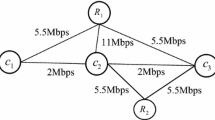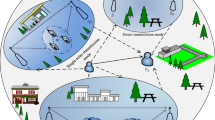Abstract
This paper proposes an interference-limited relay assignment scheme for multi-hop wireless networks that exploits cooperative diversity to cope with problems of wireless channels and to enhance data transmission reliability. By combining the selection and incremental relaying schemes and by taking into account the channel status information and queue length at each node, the cooperative scheme improves the packet dropped ratio and end-to-end delay due to retransmissions. The proposed method is based on local channel measurement and requires no topology information. In addition, this paper also investigates the interference problem produced by the relay nodes and the failure probability of the best relay selection. Extensive simulations conducted to evaluate the performance of the proposed scheme indicate that it effectively enhances the network performance in terms of the packet delivery ratio, energy consumption, and overall packet delay.









Similar content being viewed by others
References
Abouelseoud, M., & Nosratinia, A. (2013). Heterogeneous relay selection. IEEE Transactions on Wireless Communications, 12(4), 1735–1743.
Alonso-Zarate, J., Alonso, L., & Verikoukis, C. (2009). Performance analysis of a persistent relay carrier sensing multiple access protocol. IEEE Transactions on Wireless Communications, 8(12), 5827–5831.
Atapattu, S., Jing, Y., Jiang, H., & Tellambura, C. (2013). Relay selection schemes and performance analysis approximations for two-way networks. IEEE Transactions on Communications, 61(3), 987–998.
Bletsas, A., Khisti, A., Reed, D., & Lippman, A. (2006). A simple cooperative diversity method based on network path selection. IEEE Journal on Selected Areas in Communications, 24(3), 659–672.
Brennan, D. (2003). Linear diversity combining techniques. Proceedings of the IEEE, 91(2), 331–356.
El-Sherif, A., & Liu, K. (2012). Cooperation in random access networks: Protocol design and performance analysis. IEEE Journal on Selected Areas in Communications, 30(9), 1694–1702.
Feeney, L., & Nilsson, M. (2001). Investigating the energy consumption of a wireless network interface in an ad hoc networking environment. Proceedings of IEEE INFOCOM, 3, 1548–1557.
Gomez-Cuba, F., Asorey-Cacheda, R., & Gonzalez-Castano, F. (2011). A survey on cooperative diversity for wireless networks. IEEE Communications Surveys Tutorials, PP(99), 1–14.
Huang, X., Zhai, H., & Fang, Y. (2008). Robust cooperative routing protocol in mobile wireless sensor networks. IEEE Transactions on Wireless Communications, 7(12), 5278–5285.
Ibe, O. C. (2005). Fundamentals of applied probability and random processes. London: Academic Press.
Ibrahim, A., Han, Z., & Liu, K. (2008). Distributed energy-efficient cooperative routing in wireless networks. IEEE Transactions on Wireless Communications, 7(10), 3930–3941.
Ju, M., Hwang, K. S., & Song, H. K. (2013). Relay selection of cooperative diversity networks with interference-limited destination. IEEE Transactions on Vehicular Technology, 62(9), 4658–4665.
Krikidis, I., Charalambous, T., & Thompson, J. (2012). Buffer-aided relay selection for cooperative diversity systems without delay constraints. IEEE Transactions on Wireless Communications, 11(5), 1957–1967.
Krikidis, I., Thompson, J., McLaughlin, S., & Goertz, N. (2009). Max-min relay selection for legacy amplify-and-forward systems with interference. IEEE Transactions on Wireless Communications, 8(6), 3016–3027.
Laneman, J., Tse, D., & Wornell, G. (2004). Cooperative diversity in wireless networks: Efficient protocols and outage behavior. IEEE Transactions on Information Theory, 50(12), 3062–3080.
Lee, B. G., & Choi, S. (2008). Broadband wireless access and local networks: Mobile WiMAX and Wi-Fi. London: Artech House.
Myers, D. S., & Vernon, M. K. (2012). Estimating queue length distributions for queues with random arrivals. ACM SIGMETRICS Performance Evaluation Review, 40(3), 77–79.
O’Rourke, D., & Brennan, C. (2012). Practical packet combining for use with cooperative and non-cooperative ARQ schemes in resource-constrained wireless sensor networks. Ad Hoc Networks, 10(3), 339–355.
Ozdemir, M., & McDonald, A. B. (2004). An M/MMGI/1/K queuing model for ieee 802.11 ad hoc networks. In Proceedings of the 1st ACM international workshop on performance evaluation of wireless ad hoc, sensor, and ubiquitous networks, PE-WASUN ’04 (pp. 107–111).
Ren, F., He, T., Das, S., & Lin, C. (2011). Traffic-aware dynamic routing to alleviate congestion in wireless sensor networks. IEEE Transactions on Parallel and Distributed Systems, 22(9), 1585–1599.
Sharma, S., Shi, Y., Hou, Y., Sherali, H., Kompella, S., & Midkiff, S. (2012). Joint flow routing and relay node assignment in cooperative multi-hop networks. IEEE Journal on Selected Areas in Communications, 30(2), 254–262.
Uhlemann, E., & Willig, A. (2008). Joint design of relay and packet combining schemes for wireless industrial networks. In IEEE vehicular technology conference (pp. 2441–2445).
Wang, H., Li, M., Lin, J., & Yang, S. (2012). Diversity-multiplexing-delay tradeoff in selection cooperation networks with ARQ. IEEE Transactions on Communications, 60(6), 1729–1740.
Willig, A. (2008). Recent and emerging topics in wireless industrial communications: A selection. IEEE Transactions on Industrial Informatics, 4(2), 102–124.
Xie, K., Cao, J., Wang, X., & Wen, J. (2013). Optimal resource allocation for reliable and energy efficient cooperative communications. IEEE Transactions on Wireless Communications, 12(10), 4994–5007.
Zappone, A., Chong, Z., Jorswieck, E., & Buzzi, S. (2013). Energy-aware competitive power control in relay-assisted interference wireless networks. IEEE Transactions on Wireless Communications, 12(4), 1860–1871.
Zhu, Y., & Zheng, H. (2008). Understanding the impact of interference on collaborative relays. IEEE Transactions on Mobile Computing, 7(6), 724–736.
Acknowledgments
This research was supported by the MSIP (Ministry of Science, ICT and Future Planning), Korea, under the “Creative ICT Convergence Human Resource Development Program” and “The Global IT Talent Support Program (NIPA-2014-H0904-14-1005)” supervised by the NIPA (National IT Industry Promotion Agency). It was also supported by the Ministry of Education, Science Technology (MEST) and through the Human Resource Training Project for Regional Innovation 2014 with Samsung Thales. The authors would like to convey thanks to Faculty of Electrical and Electronics Engineering, Ho Chi Minh City University of Technology and Education, Vietnam and Networked Systems Lab., Kumoh National Institute of Technology, South Korea for providing laboratory facilities.
Author information
Authors and Affiliations
Corresponding author
Appendices
Appendix 1: Products of a continuous and a discrete random variables
Let X be a continuous random variable with known PDF \(f_{X}(x)\). Let also Y be a discrete random variable with PMF P(Y = y) which is defined on the interval \([0,L]\,(L>0)\). The CDF of U = XY is given by
where \(P(yX \le u|Y=y)=P(X \le \frac{u}{y}|Y=y)=F_{X}(\frac{u}{y})\) with \(y>0\). On the other hand, \(P(0X \le u|Y=0)=1\) for \(u \ge 0\) or \(P(0X \le u|Y=0)=0\) for \(u<0\). With \(u \ge 0\), Eq. (18) reduces to
However, a continuous and a discrete random variables don’t have a joint PDF because their joint distribution is not absolutely continuous in 2-dimensional plane. We make the following estimation
Appendix 2: Approximation for the M/G/1 queue length distribution
Consider an M/G/1 queue with average service time \(\overline{x}\), Poisson arrival rate \(\lambda\), and a squared coefficient of variation of service time \(c_{x}^{2}\). The probability that there are at least k + 1 packets in the queue is given by [17]
where \(U_{0}\) is the server utilization \((P[N>0]=U_{0},\,P[N=0]=1-U_{0})\) and \(\alpha =\frac{U_{0}(c_{x}^{2}+1)}{2+U_{0}(c_{x}^{2}-1)}\,(\alpha \le 1)\). Then, the CDF of queue distribution can be written as follows
for \(k=0,1,2,\ldots,L-1\), and \(P[N\le L]=1\). The PMF of queue distribution is given by
From queue length distribution, the PMF and CDF of the remaining queue length distribution can be given by
for \(k=0,1,2,\ldots,L-1\) and \(P[\overline{N}=L]=1-U_{0}\).
for \(k=1,2,\ldots,L-1\) and \(P[\overline{N}\le 0]=P[N=L]=U_{0} \alpha ^{L-1}(1-\alpha ), P[\overline{N}\le L]=1\).
The CDF calculated by Eqs. (24) and (25) conduct different results because of the estimation in Eq. (21). For instance, k = 2, then the probabilities \(P[\overline{N}\le 2]\) calculated by these equations are respectively
The difference is that \((1-\alpha )(\alpha ^{L-1} + \alpha ^{L-2}) = \alpha ^{L-2} - \alpha ^{L} \ne \alpha ^{L-2}\). However, when the server utilization \(U_{0}<1\), then \(\alpha < 1\). For a large value of queue capacity \(L, \alpha ^{L}\) converges to 0. Therefore, the difference is negligible.
Figure 10 plots the approximation for queue distribution with \(U_{0}=0.85, c_{x}^{2}=5\), and maximum queue length of 100 incoming packets.
Rights and permissions
About this article
Cite this article
Do-Duy, T., Kim, DS. Interference-aware relay assignment scheme for multi-hop wireless networks. Wireless Netw 21, 2195–2207 (2015). https://doi.org/10.1007/s11276-015-0904-5
Published:
Issue Date:
DOI: https://doi.org/10.1007/s11276-015-0904-5





